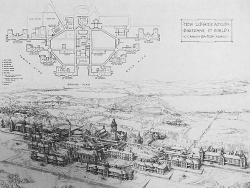St. Ita's Hospital
| St. Ita's Hospital | |
|---|---|
 | |
| Established | 1890 |
| Construction Began | 1895 |
| Construction Ended | 1903 |
| Opened | 1900 |
| Closed | 2012 |
| Current Status | Closed |
| Building Style | Echelon Plan |
| Architect(s) | George Ashlin |
| Location | Portrane, Dublin, IRE |
| Alternate Names |
|
History
With the Richmond Hospital continually overcrowded it was decided, in 1892, to erect an additional asylum for the Dublin region, covering counties Dublin, Louth, and Wicklow. Portrane House, the early eighteenth-century home of the Evans family surrounded by a 460 acre demesne, was selected as a suitable site. In August 1894 a limited architectural competition was staged to select a suitable design for the asylum. George Coppinger Ashlin (1837-1921), the partnership of Carroll & Batchelor (formed 1892), and William Kaye-Parry (1853-1932) were the finalists. Despite its higher estimated price, Ashlin's project, entitled "Aspect" and in a late Gothic Revival style, won the competition on the proviso that its cost would be reduced. Ashlin's design was ultimately successful as it offered the most space and could be realised with few modifications. Alfred Ignatius McGloughlin (1863-1940s) collaborated on the project and supervised the construction until a domestic scandal compelled him to leave Ireland for the United States circa 1900. Begun in 1896, work on the asylum was completed in 1903.
Although designed to accommodate 1,200 patients it was anticipated as early as 1895 that the issue of overcrowding would eventually emerge. In 1896, thirty women were accommodated in the original Portrane House, which later served as a residence for the Medical Superintendent prior to its demolition in the late twentieth century. From 1897 a number of temporary buildings were erected, housing up to 400 patients and continuing in use until recent years.
Saint Ita's Hospital was to prove Ashlin's largest secular commission. It was also the most expensive building supported by the British Government in Ireland. The difficulty of site access and the importation of construction materials, including slate from Antwerp, no doubt contributed to the cost, although some of the brick was supplied by the local Portmarnock Brick Company. The complexity of the plan also added to the cost. It belongs to a new generation of asylums built on an echelon or broad-arrow plan, a formula first developed at Gloucester (1879). An octagonal corridor connects a series of independent pavilion buildings, allowing each of them a clear southerly view on the sea. This plan type has nothing to do with that of a prison – rather than locking up and throwing away the key, the health of a patient was to be achieved through the sensation of space and the opening towards nature.
The symmetry of the plan is a familiar feature reflecting the then-standard practice of institutional segregation of the sexes. A central Administration Block separated two zones designated as the "Female Side" and the "Male Side". Within each "side" the patients were further separated into four categories depending on the acuteness of their illness.
In it's heyday St. Ita's operated effectively as a self-sufficient mini-town and was looked upon as a 'model' for the care of the mentally ill. Surrounded by 300 acres of farm-land and housing 2 churches, a bakery, a butcher, a tailor, a hairdresser and even a shoe repair service, this hive of industry even had its own fire station, morgue and graveyard. Food for the then 1600 patients and over 300 live-in staff was prepared and cooked in huge on-site kitchens with some of its vegetables grown in the extensive gardens on the campus. Laundry facilities required a staff of seventeen with as many patients also working on a part-time in this area.
Today, many of the buildings are no longer in use with only four long-term wards remaining open. It has been the subject of much public debate in the past decade or more but many questions as to the future of St. Ita's still remain unanswered. Back in the early days, the hospital was divided by gender with the split now being between those with a mental illness and the intellectually disabled. As residential and day-care facilities are further developed, the need for continuing care facilities at St. Ita's, it seems, will reduce even further. Eventually, it has been suggested, all acute beds for the catchment area will be provided at Beaumont Hospital.
